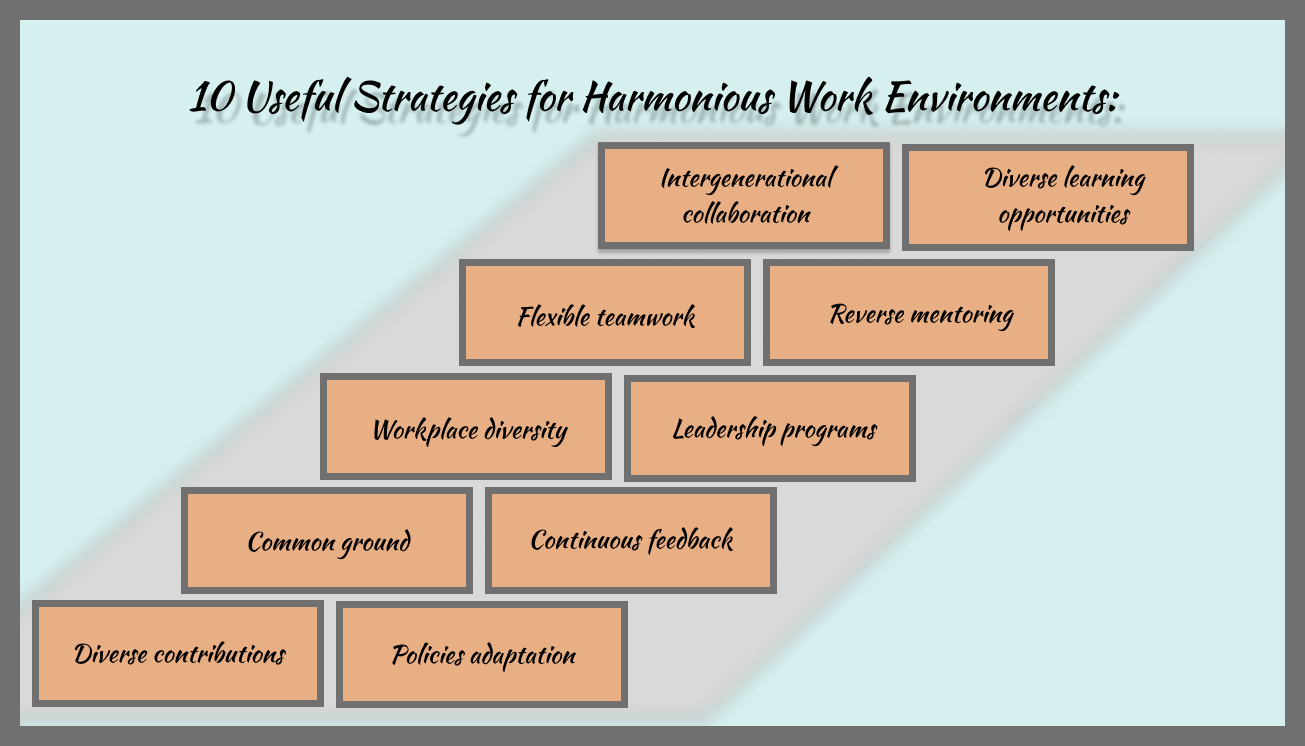Hi! It’s Michael again! As a Customer Service Manager with a decade-long career in the airline industry, I’ve come to realize that the sky isn’t the only place where diverse elements intersect. You know, guys, in the workplace, the collision of different generations can either spark vibrant synergy or create turbulence. At my job place, where I’ve been working for 10 years already, I’ve seen both. Maybe you’ve already experienced these issues at your workplace. The landscape of today’s workplace is a melting pot of ideas, attitudes, and teamwork styles shaped by distinct generation gaps in the workplace and their experiences. This realization has prompted me to reflect deeply on the dynamics of the generation gap in the workplace and help you to find strategies for coping with this complex puzzle:)
Understanding Generational Differences in the Workplace: What’s the Issue
When I worked for Airlines, I found out how the generation gap may impact the working process, either positively or negatively. The dynamics within the workplace are akin to a vibrant mosaic. You know, they’re composed of diverse generational elements, each adding its unique hue and texture. Baby Boomers, Millennials, and Gen Z—these cohorts bring with them distinct values, teamwork ethics, and communication styles shaped by their formative experiences.
Oh, Baby Boomers, I’ve met them plenty of times at my workplace, but I always managed to find a common language with them! Baby Boomers, entrenched in an era of economic prosperity post-World War II, often value hierarchical structures and loyalty to their organizations. Such people have years of experience, which contributes to a stable foundation within the workplace. These guys can always offer you their wisdom and reliability.
Conversely, Millennials, raised amid the digital revolution, prioritize flexibility, innovation, and purpose-driven work. Most of them seek a balance between professional growth and a meaningful, impactful career.
Well, these guys were a little bit more difficult for me to cope with at Airlines, so you’ll need to find a suitable approach to them:)
Gen Z, born into a world driven by technology, amplifies the need for agility, authenticity, and a tech-savvy environment. Recognizing and appreciating these differences is akin to speaking multiple languages within the same organizational framework, necessitating adaptability, empathy, and a genuine desire to comprehend each group’s perspectives and generational gap in the workplace. These people constitute the largest portion of Airlines employees, and I spent plenty of time finding a common language with them. But they’re really kind and understanding guys, as is my colleague Max.
What is the impact of baby boomers and millennials in business?
In my company, I noticed that the collision of Baby Boomers and Millennials within the professional sphere isn’t merely a clash of ideologies; it’s an opportunity for synergy. For example, Sarah, a seasoned Baby Boomer, and Alex, a tech-savvy Millennial, originally disagreed on marketing techniques, with Sarah emphasizing human contacts and Alex emphasizing digital outreach. And you know what? They achieved a bigger clientele and greater engagement by combining Sarah’s trust-based strategy with Alex’s digital knowledge! How did this happen, you may ask me? Let me explain!
Baby Boomers, often lauded for their dedication and extensive industry knowledge, possess a deep-rooted work ethic and a wealth of experience that serves as a cornerstone for stability. Their commitment to traditional hierarchical structures and face-to-face interactions anchors the workplace. That is why Sarah wanted to promote human contact in Airlines marketing.
Contrarily, Millennials inject vitality into the workplace with their penchant for innovation, adaptability, and technological prowess.
So, Alex is a typical example of a Millenial! In our company’s marketing team, he is that one special guy who always votes for new decisions, innovations, and drives progress and development. And you know, this brings us more revenue! 🙂
Millennials’ emphasis on work-life balance and purpose-driven careers reshapes the organizational landscape. Yet, these differing approaches to work can sometimes lead to misunderstandings or clashes in methodologies, like Alex and Sarah’s misunderstanding. Recognizing the unique strengths each group brings and fostering an environment of mutual respect allows for the fusion of these strengths, creating a dynamic and holistic workplace culture.
Bridging the Gap: Strategies for Harmonious Work Environments: 10 Useful Approaches
After 10 years working in the travel sphere with people of different ages and backgrounds, I’ve observed how to manage generational differences in the workplace:
- Encourage intergenerational collaboration. Create cross-functional teams comprising members from diverse age groups to work on teamwork projects. This facilitates interaction, mutual understanding, and the exchange of ideas. I’ve witnessed how building cross-departmental teams of seasoned flight crews and tech-savvy ground workers resulted in breakthroughs in the implementation of novel passenger service solutions, where the combination of expertise and current insights raised our customer experience to new heights.
- Provide diverse learning opportunities. Offer training sessions and workshops focused on understanding generational differences, communication styles, and work preferences. These initiatives promote empathy and awareness among employees, especially in the travel field.
- Flexible teamwork arrangements. Implement flexible teamwork schedules or remote work options that accommodate different lifestyle preferences. This flexibility acknowledges and respects varied work-life balance needs across generations.
- Promote reverse mentoring. Encourage younger employees to mentor senior staff on technological advancements or contemporary trends. This approach fosters knowledge exchange and mutual learning in managing generational differences in the workplace. Our Airline has implemented a program where younger employees mentor senior staff on the latest tech tools and social media trends. This great idea resulted in improved operational efficiencies and a better understanding of changing passenger preferences!
- Establish workplace diversity and inclusion initiatives. Develop programs that celebrate diversity and inclusivity, specifically addressing generational differences. This could include events, forums, or cultural exchange programs fostering understanding and respect.
- Leadership development programs. Offer leadership skills obtained from training tailored to managing multi-generational teams. Equip leaders with the skills to navigate diverse teamwork styles and perspectives effectively.
- Create common ground. Organize team-building activities or social events that bring employees from different generations together. These activities facilitate relationship-building and break down barriers.
- Encourage continuous feedback. Implement feedback mechanisms that allow employees of all ages to voice their opinions and concerns. This approach promotes a culture of listening and responsiveness and an inclusive work environment.
- Recognize and celebrate diverse contributions. Acknowledge and appreciate the contributions of employees from different generations. Highlight successes and achievements across age groups to foster a sense of inclusivity and value.
- Adapt policies and practices. Review and adapt organizational policies and practices to be more inclusive of diverse generational needs and preferences. This could include benefits, recognition programs, or career development initiatives tailored to various age groups.
How do we maintain effective communication across generational lines?
Communication forms the lifeblood of any successful organization; this is what I discovered within 10 years in Airlines. Bridging the generational gaps in the workplace necessitates not just communication but understanding the nuances of communication preferences across cohorts. Baby Boomers, accustomed to face-to-face interactions and phone calls, value personal connections and formal communication.
On the other hand, Millennials and Gen Z, shaped by technology, gravitate towards instant messaging, emails, and video conferences, prioritizing efficiency and speed.
Personally, I struggle sometimes in dealing with Gen Z because they’re much younger and have a different communication style. Once, I had to arrange a meeting with my colleague, and I wanted to do it personally, but he asked for an online video-conference. I was not against this, but for me, personal communication is much easier than for him.
So, remember, guys, finding common ground in communication styles entails creating an environment where multiple channels exist cohesively. Organizations should encourage a blend of traditional and modern communication tools, ensuring that crucial information flows seamlessly and inclusively across the diverse spectrum of generation gaps present in the workplace.
Issues of creating a cohesive team with diverse age groups
A diverse team is an asset, but it also presents challenges in harnessing its collective potential. In a workplace mosaic where Baby Boomers, Gen X, Millennials, and Gen Z coexist, fostering collaboration and respect for diverse viewpoints becomes paramount. I always try to arrange team building to raise the team spirit at our Airlines. Creating a friendly atmosphere in different generation teams is not so difficult, but it’s not without its complexities also. Varying teamwork styles, approaches to tasks, and different expectations can create friction.
Encouraging cross-generational collaboration and creating platforms where each generation’s voice is heard, valued, and integrated into decision-making processes lays the foundation for a cohesive and empowered team. Effective team dynamics are cultivated by embracing the diverse strengths of each generation, leading to greater creativity, adaptability, and resilience within the organization.
What Is the Role of Leadership in Managing Age Diversity?
As a Customer Service Supervisor, I realize that leadership within a multi-generational workforce demands a nuanced understanding of the diverse needs, aspirations, and working styles prevalent across different age groups. An effective leader acts as a bridge, connecting generations by fostering an environment where every voice feels heard and respected.
I always try to engage in various leadership styles with different people in my team, finding a personal approach for everyone!
So, guys, adaptive leadership that acknowledges and appreciates the unique contributions of each generation is pivotal. Flexibility in leadership skills styles becomes imperative—employing a one-size-fits-all approach is inadequate in managing a diverse workforce. You know, leaders must pivot between mentoring, guiding, and empowering teams based on the context and the individuals involved. Navigating the generation age gap requires leaders to transcend traditional hierarchical structures. An inclusive leadership skills approach encourages open dialogue, invites diverse perspectives, and values input from all levels of the organization.
Empathy is the cornerstone of effective leadership in this context, allowing leaders to connect with the motivations and aspirations of different generations. I always maintain empathy toward my colleagues because I understand how they may struggle sometimes with each other; I’ve already gone through this “hell.” So, creating opportunities for mentorship, coaching, and knowledge-sharing initiatives reinforces a culture of continuous learning and growth, fostering a harmonious environment where generational differences are seen as assets rather than obstacles.
What’s the Usefulness of Mentorship and Collaboration Across Generations?
How does one bridge generation gaps in the workplace? Well, mentorship programs act as bridges between generations, and mentors can foster an exchange of knowledge, skills, and experiences. Pairing younger employees with seasoned professionals doesn’t just facilitate technical skill transfer; it nurtures a deeper understanding and appreciation of diverse perspectives.
For the younger generation, these programs offer invaluable insights, guidance, and exposure to the wisdom acquired through years of experience. Simultaneously, seasoned employees benefit from fresh perspectives, innovative ideas, and a better understanding of evolving technological landscapes.
In our Airlines, the mentorship program has been transformative: younger team members share their insights on emerging travel trends and digital tools with seasoned pilots and crew, while experienced staff impart invaluable industry wisdom.
Moreover, these programs are more than just formal arrangements; they are avenues for building relationships, creating bonds, and fostering a sense of belonging across generations. Encouraging reverse mentorship, where younger employees mentor their more experienced counterparts on technological advancements or contemporary trends, further bridges the age gap and nurtures an environment of mutual learning and growth.
You can also embrace employee engagement initiatives to help employees bridge the generation gap. Some of the vast examples you may find here. According to research, these 22 approaches of some of America’s happiest workplaces may improve your everyday experience, your team, and your organization.
How Does Embracing Technological Changes and Generational Insights Help?
In our travel field, as well as any business, technology serves as a unifying force, transcending generational boundaries within the workplace. The digital era has fundamentally transformed how work is conducted, communicated, and coordinated. Embracing technological advancements isn’t merely about staying up-to-date; it’s about leveraging these tools to create a level playing field where every generation can contribute effectively.
Organizations must adopt flexible and intuitive collaboration tools that cater to diverse work styles. Integrating various communication platforms and ensuring accessibility across devices facilitates seamless interaction among employees of different age groups.
Moreover, leveraging generational insights helps in the strategic adoption and optimization of technology within the workplace. By harnessing the knowledge and expertise of different generations, organizations can make informed decisions regarding technological investments, ensuring they align with the diverse needs and preferences of their workforce.
Emily, a tech-savvy ground operations expert, was matched with Captain Rodriguez, an experienced pilot, as part of a similar mentorship program. Captain Rodriguez was exposed to cutting-edge flight planning software by Emily, while he imparted decades of aviation knowledge. This partnership not only increased operational efficiency but also created mutual respect and a fluid sharing of knowledge across generations.
What are the innovative approaches to generational challenges?
Innovation isn’t confined to technological advancements; it’s also about adopting novel approaches to resolve generational challenges. Workshops, training sessions, or cross-generational projects are effective avenues to foster understanding and empathy among employees. These initiatives create safe spaces for open dialogue, where individuals can share their experiences, expectations, and concerns freely.
Encouraging intergenerational knowledge transfer through storytelling sessions or informal gatherings allows employees to appreciate each other’s journeys, thereby fostering empathy and mutual respect.
For instance, we hosted ‘Aviation Legacy’ seminars at our airline, where veteran flight attendants and fresher recruits discussed their most memorable onboard moments. These narrative sessions not only bridged the generational divide among cabin crew members but also fostered empathy and respect for each other’s unique career in the aviation profession.
Moreover, implementing workplace diversity and inclusion training that specifically addresses generational differences cultivates an organizational culture that values and celebrates workplace diversity in all its forms. Such innovative approaches serve as catalysts for creating a workplace where generational diversity isn’t a source of division but a springboard for growth, innovation, and collective success.
Note: All names mentioned here are fictional to avoid too much popularity for my colleagues:)
If I Was Asked about the Generation Gap
- How can generational differences impact workplace dynamics?
Generational differences can significantly influence workplace dynamics by shaping communication styles, work preferences, problem-solving approaches, and perceptions of authority. If left unaddressed, these differences can lead to misunderstandings, conflicts, reduced productivity, and an overall lack of cohesion within teams.
- What strategies can be used to manage a generation gap in the workplace?
Effective strategies encompass fostering open communication channels, implementing mentorship programs, promoting collaboration through diverse projects, providing training on understanding and appreciating diverse work styles, and cultivating a culture of inclusivity and respect for differing perspectives.
- How can mentorship programs benefit different generations at work?
Mentorship programs act as conduits for knowledge exchange, skill development, and relationship building across generations. They offer younger employees guidance, exposure, and wisdom from experienced professionals, while enabling seasoned employees to stay aware of fresh perspectives and technological advancements, fostering a balanced learning environment.





